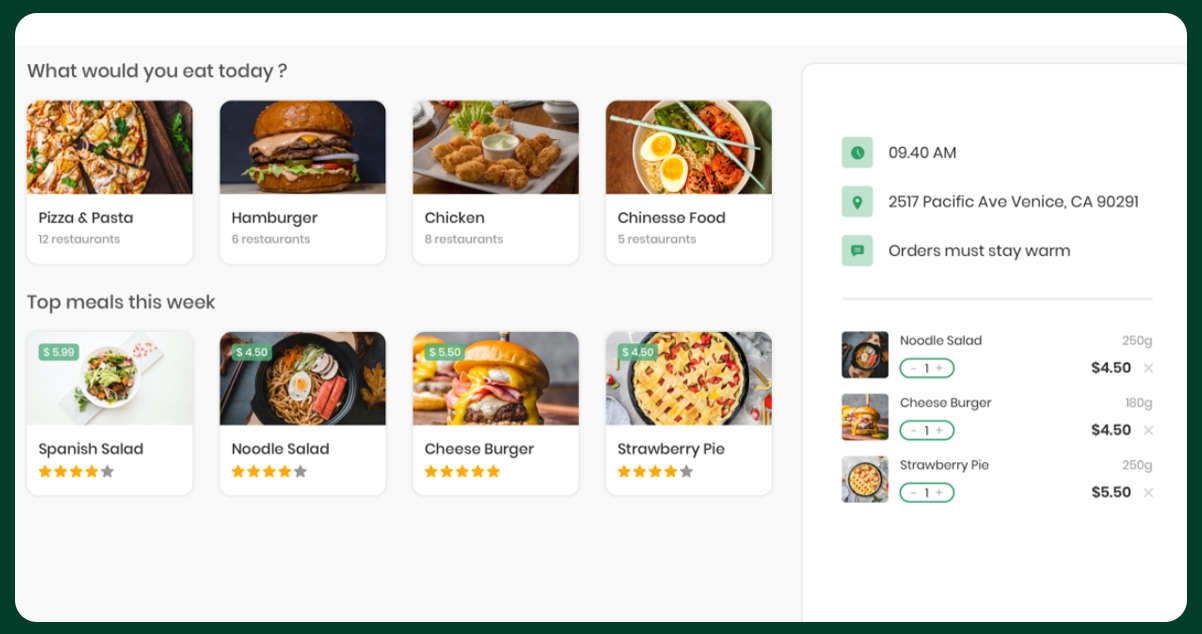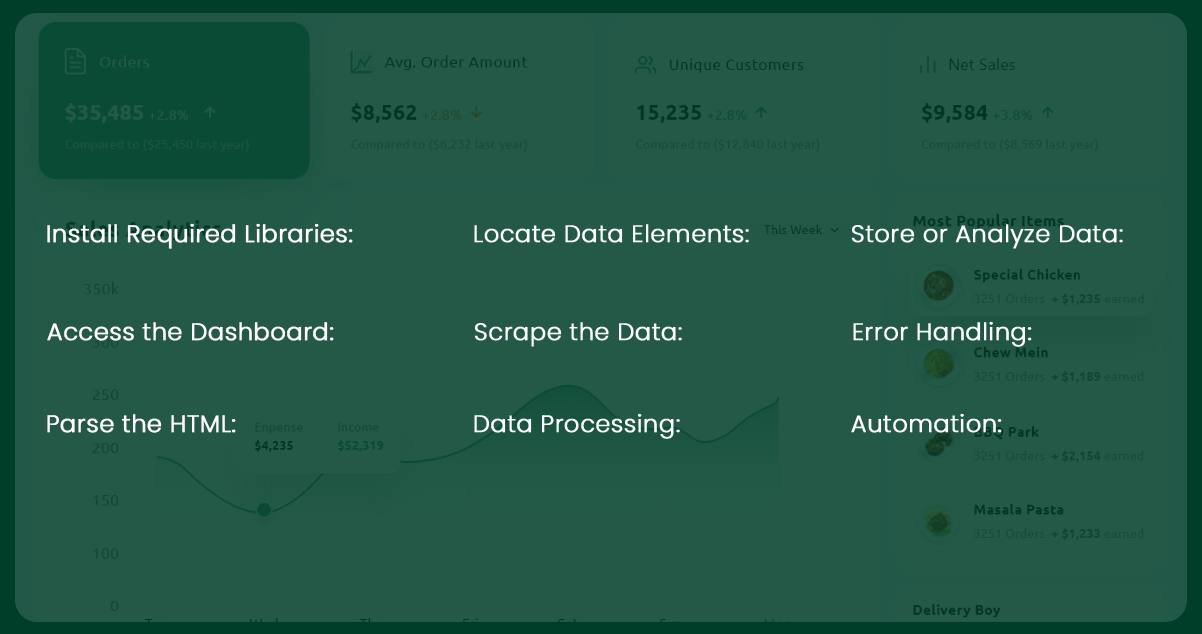"Food Dashboard Data" refers to a comprehensive set of information and statistics related to various aspects of the food industry, often presented in an easily accessible visual format on a dashboard. This data encompasses many critical insights, including food pricing, availability, consumption trends, regional variations, market analysis, and sustainability metrics. It offers valuable resources for consumers, businesses, policymakers, and researchers, helping them make informed decisions. Food dashboard data scraping empowers individuals to make cost-effective food choices, aids businesses in optimizing supply chains and offerings, assists policymakers in addressing food security concerns, and supports researchers in studying food market dynamics. This data is a vital tool for navigating the complex and ever-evolving landscape of the food industry.
Extracting food dashboard data using Python helps individuals, businesses, and policymakers access valuable information for various purposes. By sending HTTP requests and parsing HTML content, users can gather data on food prices, availability, and consumption trends, providing a basis for informed decision-making. This data aids consumers in making cost-effective purchasing choices and helps businesses optimize inventory management and pricing strategies. Policymakers benefit from insights into regional disparities and market dynamics, enabling them to craft effective policies. The process can be automated for regular updates, ensuring access to the latest data. However, adhering to legal and ethical standards is essential.
Significance of Scraping Food Dashboard Data

Scraping food dashboard data holds significant importance for various stakeholders due to the following reasons:
- Price Transparency: Food price scraping provides transparency, allowing consumers to make informed purchasing decisions, compare prices, and find cost-effective options, essential for budget-conscious individuals and families.
- Market Analysis: Businesses can utilize Food delivery Intelligence services to analyze pricing trends, understand supply and demand dynamics, and optimize pricing strategies. It empowers them to make data-driven decisions and manage inventory efficiently.
- Regional Insights: Scraped data offers insights into regional food pricing and availability variations. This information is valuable for businesses tailoring their strategies to local markets and for policymakers addressing regional food security concerns.
- Policy Formulation: Policymakers can use the scraped data to develop and evaluate food-related policies. It includes setting price controls, subsidies, and regulations to stabilize markets and ensure food affordability for vulnerable populations.
- Consumer Empowerment: Access to scraped data empowers consumers to plan their budgets effectively, especially during economic uncertainty. It allows them to adjust their purchasing habits based on price fluctuations.
- Supply Chain Optimization: Scraped data is essential for supply chain management. It aids in optimizing procurement and distribution strategies, ensuring efficient business operations.
How Can Businesses Benefit from Scraped Food Dashboard Data

Businesses can derive numerous substantial benefits from scraped food dashboard data. Firstly, it gives them a competitive edge by offering real-time insights into food pricing trends. With this information, businesses can implement flexible pricing strategies to attract cost-conscious consumers and respond to market fluctuations swiftly. This adaptability is especially crucial in the highly competitive food industry, where prices change rapidly.
Secondly, scraped data supports businesses in optimizing inventory management. Companies can adjust their procurement and stocking levels by closely monitoring price trends and demand patterns. It reduces the risk of overstocking or understocking and minimizes storage costs and potential losses due to expired or unsold products. This efficient inventory management is essential for enhancing profitability.
Moreover, scraped data facilitates localized decision-making. Food prices vary by region due to transportation costs, local demand, and supply dynamics. With access to this data, businesses can tailor their pricing and marketing strategies to specific regions and demographics, ensuring that they remain competitive and meet the unique needs of their customers in different locations.
Scraped food dashboard data is also an invaluable tool for market analysis. Businesses can use this data to understand consumer preferences better, emerging trends, and market gaps. With this knowledge, they can fine-tune their product offerings and marketing campaigns to better align with customer expectations. It, in turn, leads to more effective product development and improved customer engagement.
Furthermore, scraped data offers competitive intelligence. By monitoring competitors' pricing strategies and market positioning, businesses can make informed decisions on effectively positioning their products and services. This information is especially critical for businesses seeking an advantage in a crowded market.
Additionally, businesses can access sustainability and nutritional content data, which is increasingly important to consumers. By aligning their product offerings with evolving consumer preferences for healthier and more environmentally sustainable options, companies can appeal to a broader customer base and contribute to a positive brand image and social responsibility.
Scraped food dashboard data aids in trend forecasting as well. With insights into historical price trends and patterns, businesses can better predict future price fluctuations. This proactive approach allows companies to prepare for potential challenges and opportunities in the market, enabling them to make more informed decisions about sourcing, pricing, and inventory management.
Finally, businesses can benefit from cost savings. By staying well-informed about pricing trends and opportunities, companies can negotiate better deals with suppliers, reducing costs and increasing profit margins.
Steps Involved to Extract Food Dashboard Data Using Python Web Scraping?

To extract data from a food dashboard using Python, follow these general steps:
Install Required Libraries:
Make sure you have the necessary Python libraries installed. You'll typically need libraries like requests to make HTTP requests and BeautifulSoup for parsing HTML content.
import requests
from bs4 import BeautifulSoup
Access the Dashboard:
Use the requests library to send an HTTP GET request to the URL of the food dashboard.
url = "https://example.com/food_dashboard"
response = requests.get(url)
Parse the HTML:
Use BeautifulSoup to parse the HTML content of the dashboard.
soup = BeautifulSoup(response.content, 'html.parser')
Locate Data Elements:
Inspect the dashboard's HTML source code to identify the specific HTML elements (e.g., tables, divs) containing the data you want to scrape.
Scrape the Data:
Use BeautifulSoup to extract data from the HTML elements you identified. It might involve selecting elements by their HTML tags, attributes, or other identifying features.
data = []
for item in soup.find_all('div', class_='price'):
data.append(item.text)
Data Processing:
You can further process the scraped data depending on your needs. It could involve cleaning, formatting, or converting the data into a more usable format.
Store or Analyze Data:
You can then store the scraped data in a file (e.g., CSV, Excel) or analyze it using Python for further insights.
Error Handling:
Implement error handling for potential issues, like failed requests or missing data.
Automation:
To automate data extraction, you can wrap these steps in a script or function that runs at specified intervals.
For in-depth information, please feel free to contact Food Data Scrape. We serve as your all-in-one solution for Food Data Aggregator and Mobile Restaurant App Scraping services. Our cutting-edge insights and analytics empower well-informed decision-making, taking your business strategies to the next level. Don't hesitate to contact us today for success driven by data!
























































































